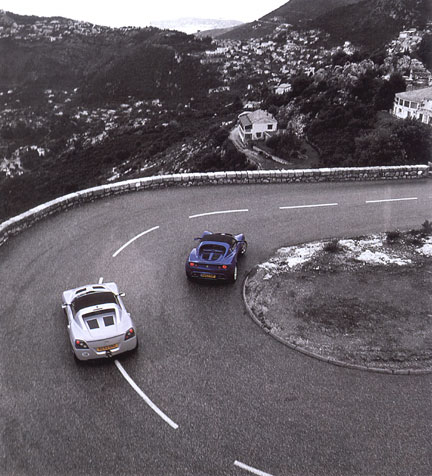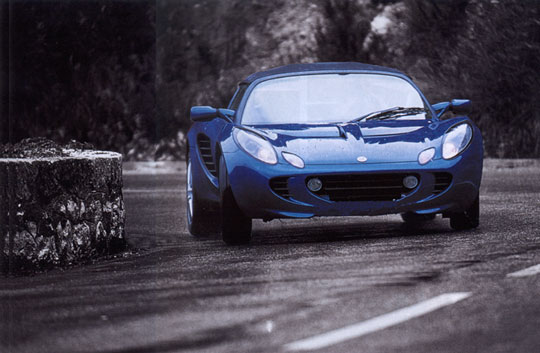
He Ain’t Heavy, He’s My Brother: Comparison of Elise with Vauxhall
They share the same basic chassis, were designed by the same people and even cost broadly the same. But which is the better sports car – the new Toyota-engined Elise or the mighty Vauxhall VX220 turbo? David Vivian went to Monaco to find out.
Written by David Vivian
The television pictures proved it. Cars with the longitudinal orientation of their wheels altered by the side of a mountain suddenly don't handle so sweetly. Not that I appreciated the reminder at midnight. Thoughts of a potentially similar fate were fading nicely when the gentle drift towards slumber was jolted into reverse by hardcore highlights from the weekend's Monte Carlo Rally quietly blazing from the box in the corner of my bedroom. Fact is, I remembered the several billion-tonne wall of stone that spannered the front wheels of Solberg's Subaru all too vividly. It was the same one that lunged at me earlier in the day.
I admit this particular surprise was only the latest in a number of surprises. The first was that I was in the south of France at the behest of Lotus, a company driven by the quest for efficiency and not traditionally given to extravagant displays of media junketry. Second, that the morning's rain in Saint-Jean-Cap-Ferrat quickly turned into the kind of blizzard conditions up in the hills that made this year's Monte so eventful. And third, finding anti-lock on the spec sheet for Hethel's new 189bhp 1.8-litre Toyota VVTLi engined Elise 111 R had lulled me into a false sense of security. Should have known better. As with the Lotus's DNA doppleganger, the Vauxhall VX220 Turbo, anti-slip electronics, however sophisticated (and the Elise boasts a state-of-the-art servo-assisted four-channel system that individually monitors and distributes braking force to each wheel as required), can only make the best of what grip they’re given by lightly laden front wheels.
I know this because, a few feet from the Elise's sexed-up rump on that excitingly slick stretch of WRC Impreza-anointed black-top, road tester Adam Towler suffered the same sudden evaporation of front-end grip under fight braking in the VX220 T he'd driven from Blighty. Something of a heart-stopper for us both.
These aren't the conditions we'd have chosen for our first drive in what Lotus is calling not only the most powerful production Elise ever but also, unequivocally, the best - much less the battleground for its first encounter with the frankly astonishing Hethel-made turbocharged VX, a car that has swiftly established itself as a towering pocket supercar talent. With a 150mph top speed and 4.9sec 0-60mph time, the 197bhp VX won't get the chance to let it all go today. Neither will the Elise (guess what - 150mph and 4.9sec). Tricky and edgy it is, then, and given the form in previous Elise/VX220 confrontations, the smart money has to be on the compliantly sprung Vauxhall, with its extraordinary flexibility and remarkably linear power delivery, coping better.

The 111R's delivery is anything but linear, but that's the big idea. The Elise has finally, after years of making do with fizzed-up K-series power, been equipped with a motor that fits its ‘performance through light weight' design philosophy and unrivalled chassis purity like a kid glove. And it's a screamer. Lifted from the Celica 190 T-Sport, Toyota's normally aspirated 1796cc: VVTL-i (Variable Valve Timing and Lift-Intelligent) 16-valve four develops its 189bhp at a dizzy 7800 rpm but supplements this with a relatively puny 1381b ft of torque at 6800rpm. The 220 T's 197 horses fine up at a comparatively calm 5500 rpm and its persuasive 1851b ft of torque at a positively chilled 1950 rpm. Hard to imagine a greater contrast. Yet it's the Elise that scalps the VX when it comes to pure power-to-weight, its 860kg at the kerb giving 220bhp per tonne versus the 70kg portlier Vauxhall's 212bhp per tonne.
Lotus chose the Toyota lump specifically for its sky-rocket power curve, light weight and compact metal matrix composite alloy cylinder block. The attached C64 six-speed gearbox completed a compelling package. Naturally, they didn't leave it at that, developing their own (T4) engine management system which sets the valve lift ‘blue touch paper' point, under optimum conditions, at 6200rpm while making the transition from brisk to bloody bell somewhat less switch-Eke than it is in the Celica. A bifurcated exhaust down pipe with twin pipes exiting through th rear diffuser and a bespoke gearshift mechanism were also designed and developed by Lotus for the 111 R. Inside the new composite sports seats are shapelier, better to look at and more comfortable, while the graphics of the usual (but now orange back-lit) twin dial instrument pack have been simplified for greater clarity. At any rate, these are the headline changes. Clear from the moment you ease your butt down into leanly cushioned seat is that Lotus's continuing efforts to improve the quality, fit, habitability and ambience of the interior are starting to pay off. It's no Boxster (owners of which Lotus claims are switching to Elises in increasing numbers) but a quick comparo with the VX parked alongside shows that there's now clear blue water between the two, despite their being built in the same factory.
The impression is massaged by the optional L1995 Touring Pack specified for the launch cars. It comprises auxiliary front driving lights, a choice of either full leather or Alcantara trim, a soft-top with sound and thermal insulation, electric windows, an upgraded Blaupunkt Woodstock DAB radio, CD player and MP3 player, an interior stowage net, sound insulation and full carpet with a lightweight aluminium passenger footrest. Standard kit isn't exactly lacking and includes half leather interior trim, tiny sun visors, central locking, a Blaupunkt Lausanne radio CD player and Blaupunkt high performance front and rear speakers.
All right, the hood still isn't 100 per cent waterproof. As we drive out of the hotel and head for the hills, a couple of drips plop down on to the broad aluminium sill from the top of the driver's door. But then it is bucketing down and, as Adam's blast through France in the VX has already made clear, being able to monitor the odd ingress of moisture would have been a luxury; in the Vauxhall you simply get wet.
That said, we're more interested in the weather's influence on driving pleasure. And, once again, Lotus has upped the ante. To go with the considerable extra grunt (another 69bhp over the standard 1.8 Elise), the already sublime chassis has been treated to another round of improvements with the aim of enhancing agility, body control and poise while, at the same time, improving both small and large bump isolation. The major hardware mod is a new, stronger rear subframe offering improved suspension and silencer mounting points. But the Eibach coaxial coil springs and Bilstein high-pressure monotube gas dampers have also been retuned and optimised. The upshot is what sounds like an alarming 20 per cent hike in spring stiffness, but Lotus chassis development ace (and current Autocar Sideways Challenge champ) Gavan Kershaw has already assured us that the figure has to be viewed in the context of the overall changes and, indeed, the countless hours his backside has put in getting it right. The Bridgestone Potenza RE040 tyres (175/551116 front, 225/45Rl7rear) are carried over from the Elise 111 S.
It isn't hard to understand why Lotus has been so keen to produce a pukka ‘super-Elise'. As thunder-stealing acts go, the VX220 T's has been formidable, acutely pointing up what the Lotus has been crying out for all this time: a decent engine and gearbox. And the combination of that epoxy-bonded aluminium tub chassis and circa 200 bhp wrapped up in a package that weighs under a ton really is phenomenal. In the dry, this Vauxhall would accelerate, corner and brake at a level that would leave many a supercar driver's face reddened. Its reputation as a pure and exhilarating driving machine shines very brightly indeed. But up here in slippery Monte country under a smoky, snow-laden sky, the VX seems, if not out of sorts, then at least not on top form. The finesse and balance that accompanies its fabulous grip in the dry seems largely to have deserted it. Understeer is setting in early and the tail seems unusually sensitive to the onset of turbo-swelled torque, requiring swift jabs of opposite lock to collect. It's far from a handful but needs careful watching and stoked-up concentration levels.
As we drop below the snowbelt and the roads return to being merely wet, the VX starts to feel its old self again. My attention is more frequently drawn to the broad-tracked chassis' increasing speed through bends with little roll and that remarkably flat and smooth (if occasionally loose-floorboard-rattly) ride. Few cars key into the road the way the superbly lithe and supple VX220 T does. The steering is just about perfectly weighted and feeds back road surface information in a gently writhing 911-esque style. Again I'm reminded why this car is so special. Mainly it's those clean, clear and effortlessly fluent helm responses. But the way the rive perfectly spaced ratios and the swift, sweet-actioned gearchange meld with the huge, linear thrust of the turbo'd 2.0-litre four comes a close second.
Even at this point I'm expecting the Lotus to finish second. But then I'm unaware of how much easier a time Adam has had in the Elise tracking the VXthrough the snow. Or how effortlessly he kept up on a brief autoroute strop.
All soon becomes clear, though. Vanishing anti-lock apart, the Elise makes a nonsense of the Vauxhall's clumsy behaviour through slush and snow. It turns in at speeds where the VX ploughs on and scavenges traction where the VXs wheels begin to spin. It may be that it simply has more outright grip and traction in such conditions. But, beyond that, and much more significantly, it inspires confidence. Such is the utter transparency and honesty of its responses that it bids you push that bit harder, revel in the purity of the feedback, the exquisite balance between steering and throttle inputs.
And that engine. It's exciting enough in the Celica. But honed and re-programmed by Lotus for the featherweight Elise - its output sliced into perfectly judged chunks by the short throw, lightning-fast six-speeder - it delivers the best high-end action rush this side of a Honda NSX Type-R.
Back down on the wet autoroute and surrounding roads, the issue is settled. The Elise feels faster than the VX220 T. More connected, more biddable, more fun, more involving and, ultimately, more of an experience. The detail of feedback it shows the driver is frankly stupendous: so pure, so precise, so free from bump and thump. And considering how good the Vauxhall is, it's little short of miraculous that the Elise 111 R betters it in every way: more hardcore and exciting at one extreme and more refined and comfortable at the other. Even at L27,995 (no more than the 111S was: Lotus has realigned its price structure) it's still L2500 more than the Vauxhall. Amazingly, though, it's the Lotus that's better value.
3 FEBRUARY 2004 WWW.AUTOCARMAG.COM
